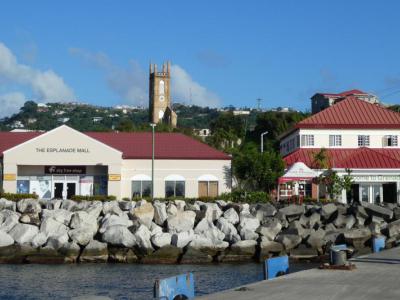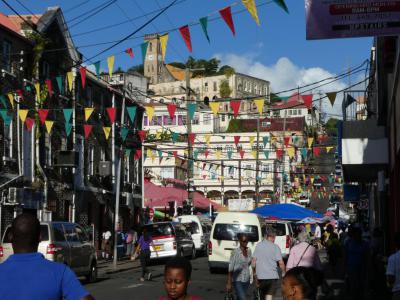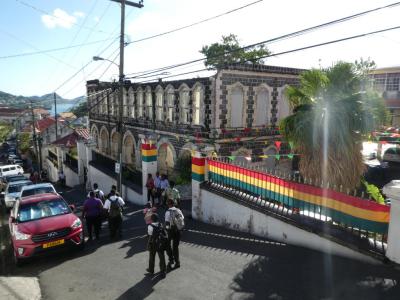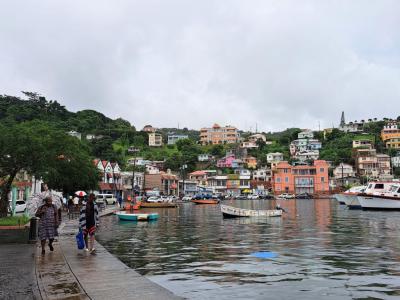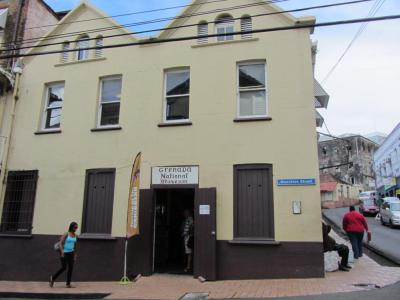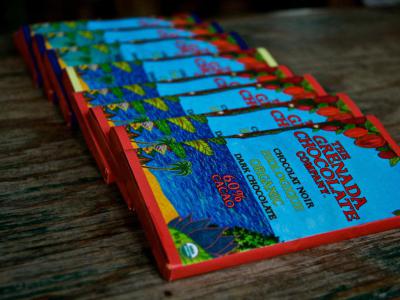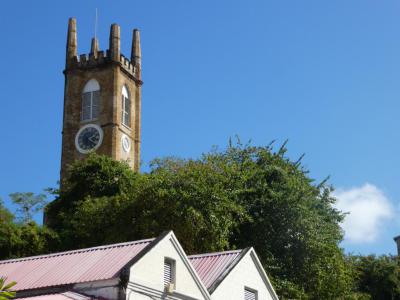
St. Georges Introduction Walking Tour (Self Guided), St. Georges
Saint George's, the capital of Grenada, epitomizes the essence of the Caribbean. Its vibrant colors, rich cultural tapestry, and deep-rooted history make it a quintessential destination. Grenada, and consequently Saint George's, is often regarded as an off-the-beaten-path gem, although recent developments hint at its evolving tourism scene.
The city was established by French settlers in 1650 as Ville de Fort Royale ("Fort Royal Town"), evolving from a modest settlement into a fortified location on a promontory overlooking Grenada's natural harbor to defend against British incursions.
In 1762, during the Seven Years' War, the British secured control of the island as part of their colonial expansion, formalizing their dominance with the Treaty of Paris in 1763. This led to the renaming of the town as Saint George's, after the patron saint of England, and Fort Royale as Fort George, after King George III, thus solidifying British authority over the region.
In the late 18th century, African slaves arrived in Saint George's to work on sugar cane plantations, yielding lucrative profits for English colonialists.
From 1833 to 1957, Saint George's was part of the British Windward Islands colony, briefly serving as its capital in the mid-1880s. Following its inclusion in the West Indies Federation, from 1958 to 1962, Saint George's became the administrative center of Grenada upon the island's declaration as an "associated self-governing state" in 1967.
Eventually, Saint George's earned the status of the capital of the independent state of Grenada in 1974. Ten years later, the government initiated political reforms that catalyzed economic growth, leading to the flourishing of tourism.
Set against the backdrop of an ancient volcano, Saint George's port is now busy with cruise liners arriving at the Cruise Ship Terminal, a gateway to Grenada's wonders.
Among the latter is the Carenage, a hub of activity with its picturesque harbor and bustling waterfront, offering a mix of maritime activity, historical charm, and cultural delights. Another must-visit location is the House of Chocolate which tantalizes the senses with its cocoa-themed exhibits and delectable treats, paying homage to Grenada's status as a top producer of fine chocolate.
While Saint George's attracts tourists, it still maintains a charm distinct from the more commercialized Caribbean cities. To experience the enchanting allure of Grenada's capital firsthand, we offer you this self-guided tour. Enjoy the walk!
The city was established by French settlers in 1650 as Ville de Fort Royale ("Fort Royal Town"), evolving from a modest settlement into a fortified location on a promontory overlooking Grenada's natural harbor to defend against British incursions.
In 1762, during the Seven Years' War, the British secured control of the island as part of their colonial expansion, formalizing their dominance with the Treaty of Paris in 1763. This led to the renaming of the town as Saint George's, after the patron saint of England, and Fort Royale as Fort George, after King George III, thus solidifying British authority over the region.
In the late 18th century, African slaves arrived in Saint George's to work on sugar cane plantations, yielding lucrative profits for English colonialists.
From 1833 to 1957, Saint George's was part of the British Windward Islands colony, briefly serving as its capital in the mid-1880s. Following its inclusion in the West Indies Federation, from 1958 to 1962, Saint George's became the administrative center of Grenada upon the island's declaration as an "associated self-governing state" in 1967.
Eventually, Saint George's earned the status of the capital of the independent state of Grenada in 1974. Ten years later, the government initiated political reforms that catalyzed economic growth, leading to the flourishing of tourism.
Set against the backdrop of an ancient volcano, Saint George's port is now busy with cruise liners arriving at the Cruise Ship Terminal, a gateway to Grenada's wonders.
Among the latter is the Carenage, a hub of activity with its picturesque harbor and bustling waterfront, offering a mix of maritime activity, historical charm, and cultural delights. Another must-visit location is the House of Chocolate which tantalizes the senses with its cocoa-themed exhibits and delectable treats, paying homage to Grenada's status as a top producer of fine chocolate.
While Saint George's attracts tourists, it still maintains a charm distinct from the more commercialized Caribbean cities. To experience the enchanting allure of Grenada's capital firsthand, we offer you this self-guided tour. Enjoy the walk!
How it works: Download the app "GPSmyCity: Walks in 1K+ Cities" from Apple App Store or Google Play Store to your mobile phone or tablet. The app turns your mobile device into a personal tour guide and its built-in GPS navigation functions guide you from one tour stop to next. The app works offline, so no data plan is needed when traveling abroad.
St. Georges Introduction Walking Tour Map






Guide Name: St. Georges Introduction Walking Tour
Guide Location: Grenada » St. Georges (See other walking tours in St. Georges)
Guide Type: Self-guided Walking Tour (Sightseeing)
# of Attractions: 10
Tour Duration: 1 Hour(s)
Travel Distance: 1.7 Km or 1.1 Miles
Author: nataly
Sight(s) Featured in This Guide:
Guide Location: Grenada » St. Georges (See other walking tours in St. Georges)
Guide Type: Self-guided Walking Tour (Sightseeing)
# of Attractions: 10
Tour Duration: 1 Hour(s)
Travel Distance: 1.7 Km or 1.1 Miles
Author: nataly
Sight(s) Featured in This Guide:
- Cruise Ship Terminal
- Market Square
- Immaculate Conception Cathedral
- York House
- Christ the Deep
- The Carenage
- Grenada National Museum
- House of Chocolate
- St. Andrew's Presbyterian Church
- Fort George
1) Cruise Ship Terminal
The Cruise Ship Terminal in St. George's, offers a distinctive experience for travelers seeking a less-traveled destination within the South and Eastern Caribbean itineraries. Situated in the heart of this small island's capital, the port boasts natural beauty and a unique charm that sets it apart from more mainstream cruise destinations.
Located at the end of a relatively new pier, the Melville Street Cruise Terminal serves as a gateway for cruise passengers exploring Grenada. With facilities designed to cater to the needs of travelers, the terminal provides essential amenities such as restrooms, ATMs, and free Wi-Fi. Additionally, the Grenada Tourism Authority operates an information kiosk within the terminal, offering valuable resources including maps and guides to help visitors make the most of their time on the island.
For those eager to venture out and explore Grenada independently, the terminal hosts several stalls providing convenient services. Travelers can purchase tickets for water taxi rides, embark on a scenic train tour of St. George's, or arrange transportation through the official taxi dispatch kiosk, ensuring regulated fares and reliable service.
Within the terminal complex, the Esplanade Shopping Mall offers a diverse array of shopping opportunities. While most shops feature local souvenirs, travelers will also find a selection of duty-free stores, including well-known brands such as Colombian Emeralds and Milano. Whether seeking unique handmade crafts or luxury goods, the mall provides options to suit every taste.
Exiting the terminal building places visitors directly onto the main street of historic St. George's downtown. Here, travelers can immerse themselves in the city's rich heritage, with landmarks and attractions just steps away. The sightseeing train ride, conveniently located nearby, offers a leisurely way to discover St. George's highlights, providing insight into the city's small, quaint, and charming character.
Located at the end of a relatively new pier, the Melville Street Cruise Terminal serves as a gateway for cruise passengers exploring Grenada. With facilities designed to cater to the needs of travelers, the terminal provides essential amenities such as restrooms, ATMs, and free Wi-Fi. Additionally, the Grenada Tourism Authority operates an information kiosk within the terminal, offering valuable resources including maps and guides to help visitors make the most of their time on the island.
For those eager to venture out and explore Grenada independently, the terminal hosts several stalls providing convenient services. Travelers can purchase tickets for water taxi rides, embark on a scenic train tour of St. George's, or arrange transportation through the official taxi dispatch kiosk, ensuring regulated fares and reliable service.
Within the terminal complex, the Esplanade Shopping Mall offers a diverse array of shopping opportunities. While most shops feature local souvenirs, travelers will also find a selection of duty-free stores, including well-known brands such as Colombian Emeralds and Milano. Whether seeking unique handmade crafts or luxury goods, the mall provides options to suit every taste.
Exiting the terminal building places visitors directly onto the main street of historic St. George's downtown. Here, travelers can immerse themselves in the city's rich heritage, with landmarks and attractions just steps away. The sightseeing train ride, conveniently located nearby, offers a leisurely way to discover St. George's highlights, providing insight into the city's small, quaint, and charming character.
2) Market Square
The Market Square stands as a premier attraction within the capital city, offering visitors an immersive experience into the local culture and traditions. Situated at the heart of St. George's, this vibrant square exudes charm with its picturesque colonial architecture and bustling ambiance.
At the core of Market Square is the bustling market itself, which stands as the largest in Grenada and serves as a focal point for both locals and tourists alike. The market is a treasure trove of sensory delights, with stalls brimming with fresh island produce, including an array of fruits, vegetables, and fragrant spices. Visitors can wander through the lively stalls, taking in the vibrant colors and aromas while immersing themselves in the authentic atmosphere of Grenada.
Beyond the market stalls, Market Square is a hub of activity where people gather to shop, eat, and socialize. On any given day, the square is alive with energy as locals and visitors mingle amidst the vibrant surroundings. Fridays and Saturdays, in particular, see Market Square at its busiest, with the air filled with the sounds of commerce and camaraderie.
For those seeking a taste of Grenada's rich cultural heritage, Market Square offers a wealth of experiences. Live entertainment, music, and dance performances often grace the square, further enhancing its lively atmosphere and providing visitors with a glimpse into the island's vibrant traditions.
At the core of Market Square is the bustling market itself, which stands as the largest in Grenada and serves as a focal point for both locals and tourists alike. The market is a treasure trove of sensory delights, with stalls brimming with fresh island produce, including an array of fruits, vegetables, and fragrant spices. Visitors can wander through the lively stalls, taking in the vibrant colors and aromas while immersing themselves in the authentic atmosphere of Grenada.
Beyond the market stalls, Market Square is a hub of activity where people gather to shop, eat, and socialize. On any given day, the square is alive with energy as locals and visitors mingle amidst the vibrant surroundings. Fridays and Saturdays, in particular, see Market Square at its busiest, with the air filled with the sounds of commerce and camaraderie.
For those seeking a taste of Grenada's rich cultural heritage, Market Square offers a wealth of experiences. Live entertainment, music, and dance performances often grace the square, further enhancing its lively atmosphere and providing visitors with a glimpse into the island's vibrant traditions.
3) Immaculate Conception Cathedral
Perched atop a hill overlooking the harbor, the Immaculate Conception Cathedral commands attention with its imposing presence and stunning views of the surrounding area. While the current cathedral was completed in 1884, its history traces back to a small chapel dedicated to Saint James, which stood on the site since 1804. The Gothic-style tower, a notable feature of the cathedral, dates back to 1818, adding to its architectural charm and historical significance.
Despite its simplicity compared to European Catholic cathedrals, the Immaculate Conception Cathedral exudes a sense of grandeur and reverence. Inside, visitors will find a tranquil space adorned with understated decorations, reflecting the humility and devotion of its worshippers.
However, the cathedral's resilience is perhaps its most remarkable attribute. Following the devastation caused by Hurricane Ivan in 2004, which inflicted severe damage upon the structure, the cathedral underwent extensive restoration efforts. Despite the challenges posed by the natural disaster, the cathedral has been meticulously restored to its former glory, a testament to the dedication and perseverance of the community.
Beyond its religious significance, the cathedral also offers visitors a unique vantage point from which to admire the beauty of Saint George's. Sitting atop the capital's hill, it provides panoramic views of the town and its picturesque surroundings, inviting contemplation and reflection.
Despite its simplicity compared to European Catholic cathedrals, the Immaculate Conception Cathedral exudes a sense of grandeur and reverence. Inside, visitors will find a tranquil space adorned with understated decorations, reflecting the humility and devotion of its worshippers.
However, the cathedral's resilience is perhaps its most remarkable attribute. Following the devastation caused by Hurricane Ivan in 2004, which inflicted severe damage upon the structure, the cathedral underwent extensive restoration efforts. Despite the challenges posed by the natural disaster, the cathedral has been meticulously restored to its former glory, a testament to the dedication and perseverance of the community.
Beyond its religious significance, the cathedral also offers visitors a unique vantage point from which to admire the beauty of Saint George's. Sitting atop the capital's hill, it provides panoramic views of the town and its picturesque surroundings, inviting contemplation and reflection.
4) York House
York House, also known as Parliament House, held a prominent place in the history and architecture of St. George's until its unfortunate demise at the hands of Hurricane Ivan in 2004. This historic landmark served as the seat of the Parliament of Grenada from the 19th century until its destruction, leaving behind a legacy of political significance and architectural splendor.
Constructed in the 1770s, York House originally served as the residence of the Depontieu family, adding a touch of elegance and grandeur to the landscape of St. George's. In 1801, the Grenada government acquired the building, transforming it into the seat of the colonial legislature. The decision to name the building after the Duke of York, who visited Grenada in the 18th century, further emphasized its stature as a symbol of colonial authority and governance.
Throughout its storied history, York House played a pivotal role in Grenada's political landscape. Following the island's independence in 1974, it became the official home of the Parliament of Grenada, serving as the venue for legislative proceedings and political debates. Additionally, the lower floor of the building housed the Supreme Court, further solidifying its importance within the judicial system.
York House bore witness to numerous significant events throughout its existence, including a visit by Queen Elizabeth II in 1985, during which she presided over a special session of Parliament. This royal visit underscored the building's status as a cornerstone of Grenada's political and cultural heritage.
Tragically, York House fell victim to the destructive forces of Hurricane Ivan in 2004, sustaining irreparable damage that rendered it uninhabitable. Following the storm, the building was abandoned, leaving behind memories of its former glory and a void in Grenada's architectural landscape.
Constructed in the 1770s, York House originally served as the residence of the Depontieu family, adding a touch of elegance and grandeur to the landscape of St. George's. In 1801, the Grenada government acquired the building, transforming it into the seat of the colonial legislature. The decision to name the building after the Duke of York, who visited Grenada in the 18th century, further emphasized its stature as a symbol of colonial authority and governance.
Throughout its storied history, York House played a pivotal role in Grenada's political landscape. Following the island's independence in 1974, it became the official home of the Parliament of Grenada, serving as the venue for legislative proceedings and political debates. Additionally, the lower floor of the building housed the Supreme Court, further solidifying its importance within the judicial system.
York House bore witness to numerous significant events throughout its existence, including a visit by Queen Elizabeth II in 1985, during which she presided over a special session of Parliament. This royal visit underscored the building's status as a cornerstone of Grenada's political and cultural heritage.
Tragically, York House fell victim to the destructive forces of Hurricane Ivan in 2004, sustaining irreparable damage that rendered it uninhabitable. Following the storm, the building was abandoned, leaving behind memories of its former glory and a void in Grenada's architectural landscape.
5) Christ the Deep
Christ the Deep, a poignant statue situated at the Carenage harbor, stands as a testament to the heroic efforts and resilience of the Grenadian people in the face of tragedy. The statue commemorates the fate of the Bianca C, an Italian luxury cruise ship often likened to the "Titanic of the Caribbean," which met a tragic end in Grenadian waters in 1961.
In the early morning hours of October 22, 1961, tragedy struck as a major explosion rocked the boiler room of the Bianca C while it was anchored at St. George's harbor. In the wake of the explosion, chaos ensued as nearly 700 passengers and crew found themselves in peril. However, in an extraordinary display of courage and compassion, local residents swiftly mobilized to rescue those aboard the stricken vessel.
Grenadian fishermen bravely manned their boats, risking their lives to pluck survivors from the water and bring them to safety. The community rallied together, setting up a makeshift hospital to tend to the injured and welcoming survivors into their homes with open arms. Despite the chaos and uncertainty, the people of Grenada demonstrated extraordinary humanity and selflessness in the face of adversity.
Tragically, the Bianca C ultimately succumbed to its fate, sinking near Grand Anse Beach two days after the initial explosion. However, the legacy of the disaster lives on in the gratitude and admiration of the survivors and their families.
In recognition of the heroic efforts of the Grenadian people, Costa Line, the owners of the Bianca C, gifted the statue known as Christ the Deep to the island. Crafted from bronze, the statue is a replica of the Christ of the Abyss, a renowned sculpture located underwater in the Mediterranean Sea near Genoa, Italy. The original sculpture was created by artist Guido Galletti.
In the early morning hours of October 22, 1961, tragedy struck as a major explosion rocked the boiler room of the Bianca C while it was anchored at St. George's harbor. In the wake of the explosion, chaos ensued as nearly 700 passengers and crew found themselves in peril. However, in an extraordinary display of courage and compassion, local residents swiftly mobilized to rescue those aboard the stricken vessel.
Grenadian fishermen bravely manned their boats, risking their lives to pluck survivors from the water and bring them to safety. The community rallied together, setting up a makeshift hospital to tend to the injured and welcoming survivors into their homes with open arms. Despite the chaos and uncertainty, the people of Grenada demonstrated extraordinary humanity and selflessness in the face of adversity.
Tragically, the Bianca C ultimately succumbed to its fate, sinking near Grand Anse Beach two days after the initial explosion. However, the legacy of the disaster lives on in the gratitude and admiration of the survivors and their families.
In recognition of the heroic efforts of the Grenadian people, Costa Line, the owners of the Bianca C, gifted the statue known as Christ the Deep to the island. Crafted from bronze, the statue is a replica of the Christ of the Abyss, a renowned sculpture located underwater in the Mediterranean Sea near Genoa, Italy. The original sculpture was created by artist Guido Galletti.
6) The Carenage (must see)
The Carenage, an enchanting horseshoe-shaped inner harbor and anchorage, stands as the vibrant heart of St. George's, offering visitors a captivating glimpse into the daily rhythms of life in this bustling Caribbean city. With its picturesque waterfront, colorful wooden schooners, and charming colonial-era buildings, The Carenage is a lively hub of activity where history and culture converge.
For over 300 years, The Carenage has provided a safe haven for sailors and their vessels, serving as a vital lifeline for trade and commerce in the region. Today, it remains a bustling maritime center, where boats of all shapes and sizes from around the world bob gently in the tranquil waters alongside charming colonial-era buildings.
Wandering along the waterfront promenade of The Carenage, visitors are treated to a sensory feast of sights, sounds, and aromas. Fishermen can be seen unloading their fresh catch from colorful wooden schooners, while locals haggle for the choicest seafood at the bustling fish market. Container ships unload supplies, adding to the lively atmosphere of this bustling maritime hub.
Aside from its maritime activities, The Carenage also offers a wealth of dining, shopping, and entertainment options. Visitors can browse the shops that line the waterfront, discovering local crafts, souvenirs, and treasures. Meanwhile, restaurants and cafes beckon with the tantalizing aromas of fresh seafood and snacks, offering the perfect opportunity to relax and savor the flavors of Grenadian cuisine.
Wharf Road, which runs along the harbor, provides excellent vantage points for soaking in the panoramic views of The Carenage and its surroundings. From here, visitors can watch the comings and goings of boats, soak in the ambiance of the bustling waterfront, and admire the charming colonial architecture that lines the seafront promenade.
For over 300 years, The Carenage has provided a safe haven for sailors and their vessels, serving as a vital lifeline for trade and commerce in the region. Today, it remains a bustling maritime center, where boats of all shapes and sizes from around the world bob gently in the tranquil waters alongside charming colonial-era buildings.
Wandering along the waterfront promenade of The Carenage, visitors are treated to a sensory feast of sights, sounds, and aromas. Fishermen can be seen unloading their fresh catch from colorful wooden schooners, while locals haggle for the choicest seafood at the bustling fish market. Container ships unload supplies, adding to the lively atmosphere of this bustling maritime hub.
Aside from its maritime activities, The Carenage also offers a wealth of dining, shopping, and entertainment options. Visitors can browse the shops that line the waterfront, discovering local crafts, souvenirs, and treasures. Meanwhile, restaurants and cafes beckon with the tantalizing aromas of fresh seafood and snacks, offering the perfect opportunity to relax and savor the flavors of Grenadian cuisine.
Wharf Road, which runs along the harbor, provides excellent vantage points for soaking in the panoramic views of The Carenage and its surroundings. From here, visitors can watch the comings and goings of boats, soak in the ambiance of the bustling waterfront, and admire the charming colonial architecture that lines the seafront promenade.
7) Grenada National Museum
Opened in 1976, the Grenada National Museum occupies a building with a storied past, having served as French barracks, a prison, hotels, and a warehouse before being transformed into a beacon of cultural preservation. Stepping inside the Grenada National Museum, visitors are greeted with a treasure trove of historical artifacts and exhibits that span the island's rich and diverse heritage. From the earliest inhabitants to the colonial era, slavery, plantation economy, and beyond, the museum offers immersive displays that shed light on pivotal moments and chapters in Grenada's history.
Among the museum's highlights are artifacts and collections that depict key political and social events, such as Grenada's journey to independence, the Grenada Revolution, and the assassination of Prime Minister Maurice Bishop. One notable piece is a marble bathtub believed to have been used by Empress Josephine Bonaparte during her childhood, adding a touch of international intrigue to the museum's offerings.
In addition to its focus on historical events and figures, the Grenada National Museum celebrates the island's vibrant cultural heritage. Visitors can explore exhibits showcasing Grenadian festivals, traditions, and ways of life, gaining insight into the rich tapestry of indigenous culture that shapes the island's identity.
Beyond its exhibits, the museum offers a variety of activities and amenities for visitors to enjoy. Live cultural performances, including jazz, dancing, drumming, singing, and poetry, provide immersive experiences that bring Grenada's vibrant culture to life. Additionally, the museum boasts an outdoor café and bistro where visitors can savor a meal in the historical setting of the museum grounds.
Among the museum's highlights are artifacts and collections that depict key political and social events, such as Grenada's journey to independence, the Grenada Revolution, and the assassination of Prime Minister Maurice Bishop. One notable piece is a marble bathtub believed to have been used by Empress Josephine Bonaparte during her childhood, adding a touch of international intrigue to the museum's offerings.
In addition to its focus on historical events and figures, the Grenada National Museum celebrates the island's vibrant cultural heritage. Visitors can explore exhibits showcasing Grenadian festivals, traditions, and ways of life, gaining insight into the rich tapestry of indigenous culture that shapes the island's identity.
Beyond its exhibits, the museum offers a variety of activities and amenities for visitors to enjoy. Live cultural performances, including jazz, dancing, drumming, singing, and poetry, provide immersive experiences that bring Grenada's vibrant culture to life. Additionally, the museum boasts an outdoor café and bistro where visitors can savor a meal in the historical setting of the museum grounds.
8) House of Chocolate (must see)
The House of Chocolate Grenada Museum stands as a delightful and informative attraction, celebrating Grenada's vibrant cocoa production and chocolate-making culture. Nestled in the heart of St. George's, this charming museum offers visitors a captivating journey through the history, artistry, and flavors of chocolate.
At the House of Chocolate, guests are invited to immerse themselves in the fascinating world of cocoa production and chocolate crafting. Through a series of interactive exhibits, audio-visual presentations, and live demonstrations, visitors gain insight into every stage of the chocolate-making process, from the cultivation of cocoa trees to the creation of delectable chocolate treats. Learn about the traditional methods used by Grenadian farmers to harvest cocoa beans and discover the secrets behind crafting exquisite chocolate bars.
The museum not only educates but also indulges the senses, allowing visitors to sample a variety of decadent chocolate creations freshly made on-site. From rich and velvety chocolate bars to creamy truffles and artisanal bonbons, there's something to satisfy every sweet tooth.
In addition to its educational exhibits, the House of Chocolate features a cozy café where visitors can savor delicious chocolate treats while basking in the museum's inviting ambiance. Whether enjoying a cup of rich hot chocolate or indulging in a slice of chocolate cake, guests can delight in the flavors of Grenada's finest cocoa creations.
For those looking to take a piece of Grenada's chocolate culture home with them, the museum's boutique offers a curated selection of cocoa-inspired products, including handcrafted chocolates, cocoa-infused skincare products, and artisanal souvenirs. From gourmet chocolate bars to cocoa-scented candles, the boutique is a treasure trove of delights for chocolate enthusiasts and connoisseurs alike.
At the House of Chocolate, guests are invited to immerse themselves in the fascinating world of cocoa production and chocolate crafting. Through a series of interactive exhibits, audio-visual presentations, and live demonstrations, visitors gain insight into every stage of the chocolate-making process, from the cultivation of cocoa trees to the creation of delectable chocolate treats. Learn about the traditional methods used by Grenadian farmers to harvest cocoa beans and discover the secrets behind crafting exquisite chocolate bars.
The museum not only educates but also indulges the senses, allowing visitors to sample a variety of decadent chocolate creations freshly made on-site. From rich and velvety chocolate bars to creamy truffles and artisanal bonbons, there's something to satisfy every sweet tooth.
In addition to its educational exhibits, the House of Chocolate features a cozy café where visitors can savor delicious chocolate treats while basking in the museum's inviting ambiance. Whether enjoying a cup of rich hot chocolate or indulging in a slice of chocolate cake, guests can delight in the flavors of Grenada's finest cocoa creations.
For those looking to take a piece of Grenada's chocolate culture home with them, the museum's boutique offers a curated selection of cocoa-inspired products, including handcrafted chocolates, cocoa-infused skincare products, and artisanal souvenirs. From gourmet chocolate bars to cocoa-scented candles, the boutique is a treasure trove of delights for chocolate enthusiasts and connoisseurs alike.
9) St. Andrew's Presbyterian Church
Saint Andrew's Presbyterian Church, also known as Saint Andrew's Kirk, stands as a testament to Grenada's rich heritage and the enduring legacy of Scottish immigrants who settled on the island in the early 19th century. Founded in 1830, Saint Andrew's Kirk was built to serve as a place of worship and community gathering for the growing Presbyterian population in Grenada.
Construction of the church was completed in 1833, with its impressive clock tower standing as a prominent landmark overlooking Saint George's Inner Harbour. The clock tower, adorned with a bell cast in Glasgow, Scotland, serves not only as a functional timepiece but also as a symbol of the church's Scottish roots and the enduring ties between Grenada and Scotland.
Tragically, Saint Andrew's Kirk suffered significant damage during Hurricane Ivan on September 7, 2004, leaving the church in a state of disrepair. Despite the passage of time, repairs to the church have yet to be completed, leaving the building as a poignant reminder of the destructive power of nature and the resilience of the community.
Despite its current condition, Saint Andrew's Kirk remains a cherished symbol of faith and heritage in Grenada. Visitors to Saint George's can still admire the church's iconic clock tower, which stands as a beacon atop a hill overlooking the cruise terminal. The tower serves as a guidepost for those seeking to explore the surrounding area, with a staircase leading up to a path that winds its way to Fort George, offering breathtaking views of the harbor and the surrounding landscape along the way.
Construction of the church was completed in 1833, with its impressive clock tower standing as a prominent landmark overlooking Saint George's Inner Harbour. The clock tower, adorned with a bell cast in Glasgow, Scotland, serves not only as a functional timepiece but also as a symbol of the church's Scottish roots and the enduring ties between Grenada and Scotland.
Tragically, Saint Andrew's Kirk suffered significant damage during Hurricane Ivan on September 7, 2004, leaving the church in a state of disrepair. Despite the passage of time, repairs to the church have yet to be completed, leaving the building as a poignant reminder of the destructive power of nature and the resilience of the community.
Despite its current condition, Saint Andrew's Kirk remains a cherished symbol of faith and heritage in Grenada. Visitors to Saint George's can still admire the church's iconic clock tower, which stands as a beacon atop a hill overlooking the cruise terminal. The tower serves as a guidepost for those seeking to explore the surrounding area, with a staircase leading up to a path that winds its way to Fort George, offering breathtaking views of the harbor and the surrounding landscape along the way.
10) Fort George (must see)
Constructed between 1706 and 1710, Fort George is revered as the most significant historical structure in St. George's, having played a pivotal role in shaping the island's tumultuous history over the past three centuries. Notably, the fortress was the site of the decisive end to the Grenada Revolution on October 19, 1983, marking a significant moment in the island's history. Today, Fort George continues to hold a prominent place in Grenada's landscape, serving as the headquarters of the Royal Grenada Police Force.
Originally named Fort Royal, the fortress was renamed Fort George in 1763 in honor of King George III when the British seized control of Grenada. Designed as a bastion tracer fort, Fort George boasts strategic features that allowed for effective defense, including layers of fortified levels capable of providing covering fire for one another. The architecture reflects classic European fortifications, with notable elements such as a parade ground, barracks, guardroom, gunpowder magazine, water cistern, sally port, cannons, and firing galleries.
One of the highlights of visiting Fort George is the unparalleled panoramic views it offers. From its elevated position, visitors can marvel at sweeping vistas of St. George's Town, the bustling harbor, the picturesque southern coastline, and the vast expanse of the ocean beyond. For those seeking to capture memories of their visit, the fortress still maintains a battery of old cannons, providing excellent photo opportunities against the backdrop of Grenada's scenic beauty.
Accessing Fort George is straightforward, with steps leading up from beside the exit to the Sendall tunnel or via the main road leading to the General Hospital. Whether drawn by its historical significance, architectural grandeur, or breathtaking views, a visit to Fort George promises an unforgettable journey through Grenada's rich past.
Originally named Fort Royal, the fortress was renamed Fort George in 1763 in honor of King George III when the British seized control of Grenada. Designed as a bastion tracer fort, Fort George boasts strategic features that allowed for effective defense, including layers of fortified levels capable of providing covering fire for one another. The architecture reflects classic European fortifications, with notable elements such as a parade ground, barracks, guardroom, gunpowder magazine, water cistern, sally port, cannons, and firing galleries.
One of the highlights of visiting Fort George is the unparalleled panoramic views it offers. From its elevated position, visitors can marvel at sweeping vistas of St. George's Town, the bustling harbor, the picturesque southern coastline, and the vast expanse of the ocean beyond. For those seeking to capture memories of their visit, the fortress still maintains a battery of old cannons, providing excellent photo opportunities against the backdrop of Grenada's scenic beauty.
Accessing Fort George is straightforward, with steps leading up from beside the exit to the Sendall tunnel or via the main road leading to the General Hospital. Whether drawn by its historical significance, architectural grandeur, or breathtaking views, a visit to Fort George promises an unforgettable journey through Grenada's rich past.
The Most Popular Cities
/ view all
